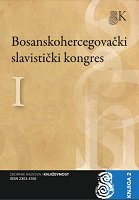Travnik kao orijentalni balkanski grad (Travnička hronika I. Andrića)
Travnik as a Balkan City of the Oriental Type (Ivo Andrić’s Travnik Chronicle)
Author(s): Irina IvanovaSubject(s): Bosnian Literature, The Ottoman Empire, Theory of Literature, Stylistics, Sociology of Literature
Published by: Slavistički komitet BiH
Keywords: Charshia; Balkan town; Balkan house; mahala; divanhana; sheher;
Summary/Abstract: The paper is devoted to the cultorological concept ‘Balkan town’, whose features can also be found in other Southern Slavic localities which developed under the Ottoman rule. Elements of this concept are visible in the Travnik Chronicle by Ivo Andrić. Thus, a very important role in the novel is played by ‘charshia’. Travnik was built as a Turkish city. The old Seljuk tradition of urban dwelling organization was transferred onto the newly acquired Balkan territories. Thus, each city was divided into charshia, a market and craftsmen’s area, and mahals, residential areas. Charshia was the place for economic and social life. This area consisted of numerous streets, composed of low-rise wooden buildings, workshops and stores. Charshia also housed community buildings, which used to be architecturally accentuated in oriental cities. These buildings included inns, a caravan-serai, baths, educational institutions and mosques. The charshia was open daily from early morning till sunset. It was closed only in difficult times when the town was facing some serious threat or when the town dwellers wanted to protest in times of public unrest. The Travnik Chronicle describes the unrest. The paper also deals with typical structure of a Balkan town, as well as a Balkan house.
Journal: Bosanskohercegovački slavistički kongres
- Issue Year: I/2012
- Issue No: 2
- Page Range: 289-295
- Page Count: 7
- Language: Bosnian

